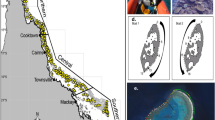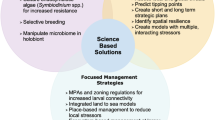Summary
The Miocene sequences of southwestern Turkey and the Recent Red Sea are characterised by an unusual and distinct sedimentary association. In both cases near-shore patch and fringing reefs occur along the margins of alluvial fans and braidplains developed under semiarid climatic conditions. In such an environment reef location, morphology and internal structure are controlled primarily by the clastic sedimentary system rather than the independent growth of the framework builders as in normal reef environments. The primary control is a morphological one, the reefs adopting the overall geometry of the sediment body forming a fan shaped arcuate belt. Irregularities in reef morphology are clearly related to the presence of fluvial channels on the fans. The coarse grained gravel of the fans provide an ideal substrate for coral colonisation, this is reflected in the lack of a pioneer community in the Miocene reefs. Periodic rapid burial of the reefs terminates the production of carbonate debris by mechanical and biological erosion resulting in preservation of a relatively unaltered primary framework. The inter-reef sediment consists exclusively of terrigenous sediment.
Similar content being viewed by others
References
Clifton HE (1973) Pebble segregation and bed lenticularity in wave worked versus alluvial gravel. Sedimentology 20:173–189
Dabrio CJ (1975) La sedimentariai arrecifal Neogena en la region del vio Almonzaru Esteidious. Geologicas 41:285–296
Friedman GM (1968) Geology and geochemistry of reefs carbonate sediments, and waters, Gulf of Aqaba (Elat), Red Sea. J Sediment Petrol 38:895–919
Friedman GM (1972) Significance of Red Sea in the problem of evaporites and basinal limestones. Am Assoc Petrol Geol Bull 56:1072–1086
Gwirtzmann G, Buchbinder B (1978) Recent and Pleistocene coral reefs and coastal sediments of the Gulf of Eilat. In: Post Congr Guide-book, Tenth Int Congr Sediment Jerusalem, pp 163–189
Hayward AB (1982) Coastal alluvial fans and associated marine facies Miocene SW Turkey. In: Collinson, JD (ed.) Fluvial sedimentology. Sedimentology Spec Publ (in press)
Hsu KJ, Ryan WBF, Cita MB (1973) Late Miocene dessication of the Mediterranean. Nature 242:240–244
James NP (1972) Late Pleistocene Reef Limestones, N. Barbados, West Indies. Unpubl PhD Thesis, McGill University, Montreal, 242 pp
James NP (1979) Facies models 11. Reefs. In: Walker RG (ed) Facies Models Geoscience Canada, Reprint Series 1:121–132
Johnson H (1978) Shallow siliciclastic seas. In: Reading HG (ed) Sedimentary environments and facies. Blackwell Scientific Publications, Oxford, pp 207–258
Klinker J, Reiss Z, Dropach C, Levanon I, Harpaz H, Halicz E (1976) Observation on the circulation pattern in the Gulf of Elat (Aqaba), Red Sea. Israel J Earth Sci 25:85–103
Logan BW, Harding JL, Alan WM, Williams JD and Snead RG (1969) Carbonate sediments and reefs, Yucatan shelf, Mexico. Am Assoc Petrol Geol Mem 11:1–355
Loya Y (1972) Community structures and species diversity of hermatypic corals at Eilat, Red Sea. Mar Biol 13:100–123
Martindale W (1976) Calcareous encrusting organisms of the Recent and Pleistocene reefs of Barbados, West Indies. Unpubl PhD thesis, University of Edinburgh, 141 pp
Mesolella KJ, Sealy HA, Matthews RK (1970) Facies geometries within Pleistocene reefs of Barbados, W. Indies. Am Assoc Petrol Geol Bull 54:1899–1977
Milliman JD, Ross DA, Ku TL (1969) Precipitation and lithification of deep-sea carbonates in the Red Sea. J Sediment Petrol 39:724–736
Santisteban C, Taberner C (1980) Reefs in the Upper Miocene of Spain. In: Reefs past and present. 2, Cambridge (Abstract only)
Schroeder JH, Zank LH (1974) Dynamic reef formation: a sedimentological concept based on studies of Recent Bermuda and Bahama reefs. Proc 2nd Int Coral Reef Symp II, Gt Barrier Reef Comm, Brisbane, pp 413–428
Scoffin TP, Garrett P (1974) Processes in the formation and preservation of internal structure in Bermuda Patch Reefs. Proc 2nd Int Coral Reef Symp II, Gt Barrier Reef Comm, Brisbane, pp 429–449
Stoddart DR (1969) Ecology and morphology of Recent coral reefs. Biol Rev 44:433–498
Author information
Authors and Affiliations
Rights and permissions
About this article
Cite this article
Hayward, A.B. Coral reefs in a clastic sedimentary environment: Fossil (Miocene, S.W. Turkey) and modern (Recent, Red Sea) analogues. Coral Reefs 1, 109–114 (1982). https://doi.org/10.1007/BF00301692
Received:
Accepted:
Issue Date:
DOI: https://doi.org/10.1007/BF00301692




